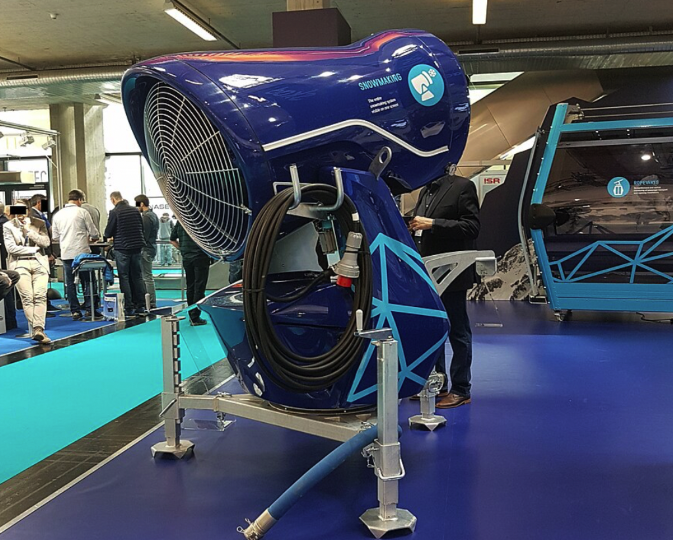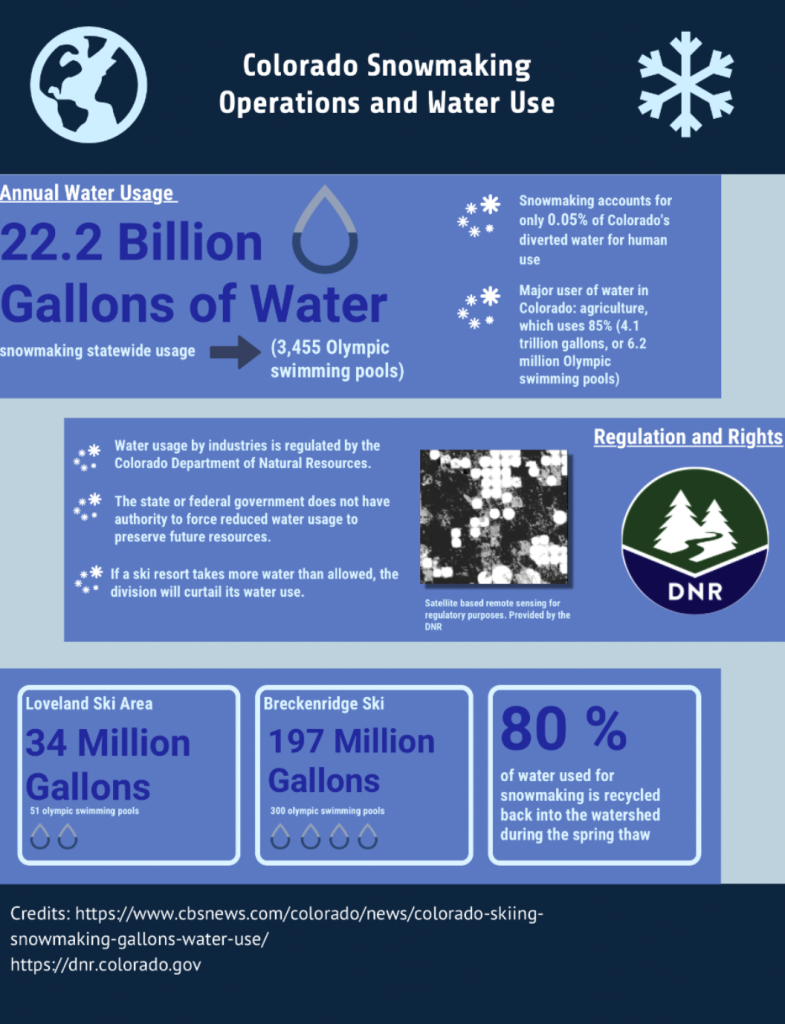
No Business like Snow Business: Colorado's Ski Resorts Make It Rain
In recent years, Colorado’s renowned ski industry has faced a growing dilemma: the steady decline of natural snowfall. With the reliability of natural snow diminishing, ski resorts have been forced to adapt or risk losing their competitive edge. Enter artificial snowmaking technology—a double-edged sword in the battle against warming temperatures.
Colorado’s ski industry has thrived on its natural snowfall, drawing millions of visitors annually and contributing significantly to the state’s economy. Due to climate change, ski resorts such as Telluride, Vail and Breckenridge, and a great portion of other ski resorts across the picturesque landscapes of Colorado have started to embrace snowmaking technology as a lifeline to ensure consistent snow coverage throughout the ski season.
These resorts, which collectively rake in over $4.8 billion annually, provide employment for more than 46,000 individuals year-round and view artificial snow as a necessary adaptation to the changing climate.
Colorado’s ski industry has witnessed a revolution in snowmaking technology, with resorts investing heavily to ensure optimal skiing conditions for guests. The largest snowmaking investment project in North America, led by popular resorts like Vail, has paved the way for groundbreaking advancements in snow surface quality and coverage.
This investment has translated into tangible benefits for skiers, with resorts like Arapahoe Basin opening as early as the end of October, marking the start of the ski season in Colorado. Thanks to snowmaking technology, ski areas can now open their slopes earlier and stay open longer, providing enthusiasts with extended opportunities to enjoy their favorite winter sport.
But how exactly does snowmaking work? It’s a sophisticated process that relies on a combination of compressed air, compressed water and powerful snow guns. Snowmakers closely monitor weather conditions, particularly the wet bulb temperature, to determine the optimal time for snow production. Cold, dry weather with low wind is ideal, allowing for the efficient creation of snow that closely resembles the real thing.
Steamboat Ski Resort, for example, draws water from the nearby Yampa River to power its snowmaking operations. With teams of dedicated snowmakers working around the clock, resorts can pump thousands of gallons of water per minute and run dozens of snow guns simultaneously.
However, this technological intervention is not without consequences. One of the most significant criticisms leveled against artificial snow is its voracious appetite for water. To cover just a single acre with a layer of artificial snow, up to 175,000 gallons of water are required, placing strain on local water resources, particularly in Colorado’s arid regions. The composition of artificial snow raises additional concerns.
Chemical additives, such as nucleating agents, are often incorporated into the snowmaking process to facilitate production. This raises fears of water contamination and soil degradation, potentially harming the delicate ecosystems that surround these resorts.
In August 2023, Colorado Attorney General Phil Weiser announced that the Colorado Natural Resources Trustees approved a $275,000 settlement with the owner of Vail Mountain over an incident that ended in two million gallons of contaminated water being released into local creeks two years prior
“Water, it’s the very source of life in Colorado’s mountain towns. It’s not just about making snow for our ski slopes; it’s about sustaining our communities, our ecosystems, and our way of life. But with the changing climate, we’re seeing increasing strain on our local water resources, Dennis Ojima, Colorado State Climatologist said. “From dwindling snowpacks to more frequent droughts, the signs are clear: we can’t keep using water the way we always have. We’re facing tough choices ahead. We’ve got to balance the needs of our ski industry with the realities of our finite water supply.”
Furthermore, the process of snowmaking itself releases greenhouse gasses, exacerbating the very climate change that ski resorts are striving to mitigate. This paradox underscores the complex interplay between adaptation measures and their unintended environmental impacts.
Take Vail and Breckenridge, two iconic ski resorts synonymous with Colorado’s winter wonderland, for example. These industry giants have led initiatives to embrace artificial snow while treading lightly on the environment. From utilizing recycled water for snowmaking to investing in energy-efficient snowmaking equipment, these resorts are attempting to balance profitability with environmental responsibility.
Despite these challenges, the ski industry maintains that artificial snow is a necessary evil in the face of climate change. However, critics argue that these measures fall short in addressing the broader issue of climate change and its long-term impact on the winter climates.
“Artificial snow might keep the ski slopes bustling, but we have got to think about how it is really affecting the whole mountain ecosystem. It is not just about the skiers; it’s about the critters too. From changing habitats for wildlife to messing with our waterways downstream, artificial snow could shake things up more than I believe society realizes,” Ojima said.
On the flip side, small businesses, from ski rental shops to restaurants and boutiques, benefit from increased foot traffic and spending by winter enthusiasts drawn to the region by reliable snow conditions. This symbiotic relationship between snowmaking technology and local businesses underscores the vital role that innovation plays in sustaining Colorado’s mountain economy.
Likewise, hotels and lodges experience higher occupancy during extended ski seasons, and transportation services, like shuttle buses and car rentals, see more business due to steady visitor flow. This boost in revenue helps keep the local economy going during quieter seasons.
“Being an environmentalist at heart, I’ve had my reservations about artificial snow,” said Christina Mora, assistant manager of Vail Ski Tech, a local ski store. “But seeing the benefits firsthand, I can’t deny its impact on our business and community. With reliable snow from the snowmaking tech, we have been able to keep our doors open a couple more days a week or even a couple more notable days a season.”
While acknowledging the environmental concerns associated with artificial snow, Washburn emphasizes the importance of finding sustainable and safe solutions.
“As long as they come up with something good and safe, I’ll be happy to see our shop thriving,” Mora said.
As the debate rages on, transparency and accountability emerge as key pillars in navigating the delicate balance between profitability and sustainability. Colorado consumers are increasingly scrutinizing the environmental practices of businesses, including ski resorts, signaling a shift towards greater accountability in the pursuit of winter recreation.
“Snowmaking involves heavy machinery that uses a lot of energy and releases greenhouse gasses,” Ojima said. “So, there’s this paradox—making artificial snow is contributing to the very climate change that’s causing the need for it.”


